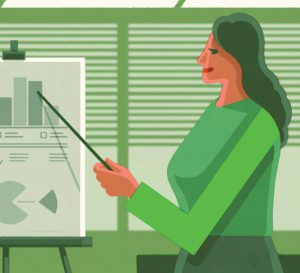Stay on top of your business game with the latest from Haas classrooms.
Whether you graduated five years or 25 years ago, business and leadership are evolving fields, and classes at Berkeley Haas are constantly updated or created to address the skills and knowledge needed in today’s workplaces. Here, we bring you insights from some of our newest MBA classes with resources for staying on top of the trends.
Leading Diverse Teams
 Business Communication in Diverse Work Environments, a new core class taught by a team of Haas professors, offers a variety of expertise. New Assistant Professor Sa-kiera Tiarra Jolynn Hudson, who will begin teaching the course this spring, says the class aims to provide the tools to analyze, reason, and acknowledge other perspectives, so leaders can problem-solve identity dynamics within their own organizations. “A person might notice that only a select few in their group are speaking up,” she says. “Before immediately assuming a lack of competence, we hope for people to first analyze the power dynamics within the group related to gender, race, political orientation, etc.” Here are three pieces of advice from the class.
Business Communication in Diverse Work Environments, a new core class taught by a team of Haas professors, offers a variety of expertise. New Assistant Professor Sa-kiera Tiarra Jolynn Hudson, who will begin teaching the course this spring, says the class aims to provide the tools to analyze, reason, and acknowledge other perspectives, so leaders can problem-solve identity dynamics within their own organizations. “A person might notice that only a select few in their group are speaking up,” she says. “Before immediately assuming a lack of competence, we hope for people to first analyze the power dynamics within the group related to gender, race, political orientation, etc.” Here are three pieces of advice from the class.
We are all capable of changing our biases once we understand how they affect our judgment, decisions, and behavior at work.
End groupthink
This requires a change of mindset from knowing what you’re going to say in a meeting to beginning with an open mind and asking questions. To show students the irrational side of groupthink, Professor Laura Kray runs a hiring simulation, asking students to consider three female job candidates. Kray found that students usually pick an inferior candidate because the group focuses on one thing they agree on, such as where the candidate went to school, and ignores the negative information about that candidate. “You spend the majority of your meeting talking about what you already know,” Kray says. “It’s a phenomenon that happens in groups and you have to be systematic to overcome it.”
Consider inequalities inside—and outside—of organizations
Professor Sameer Srivastava stresses the power that people have to dismantle structural barriers in the workplace and in the communities where they work. He teaches a case study of West Side United (haas.org/west-side)—a consortium of hospitals in Chicago that’s trying to address the stark gap in life expectancies among residents in the city’s different neighborhoods by working closely with community leaders.
Understand implicit bias
Implicit bias applies to the assumptions we make about people based on race, ethnicity, age, gender, LGBTQ+ identity, and ability. We are all capable of changing our biases once we understand how they affect our judgment, decisions, and behavior at work, says Assoc. Prof. Dana Carney. “We’re in a new time where people might not look like what they identify as,” she says. “When you don’t know, ask.”
Business as climate change mitigator
 You don’t need to be in a sustainability-focused role to make changes that are meaningful to the planet, says Lecturer Chris Jones, director of the CoolClimate Network, a university-government-industry-NGO collaboration at Berkeley. In his Carbon Footprint Analysis for Innovation class, Jones provides tools that can be used by people working in strategy, investor relations, corporate accounting, or marketing and communications.
You don’t need to be in a sustainability-focused role to make changes that are meaningful to the planet, says Lecturer Chris Jones, director of the CoolClimate Network, a university-government-industry-NGO collaboration at Berkeley. In his Carbon Footprint Analysis for Innovation class, Jones provides tools that can be used by people working in strategy, investor relations, corporate accounting, or marketing and communications.
“We need to work in all of our spheres of influence—from work to the community to household emissions,” he said. “How do you use your own potential to create something new?”
Jones stresses “marginal contributions” that add up. For example, one of his students who works at a big tech company that relies on scores of servers proposed an idea to reduce server load by identifying a uniform way to consolidate repetitive computer code to make servers run more efficiently. Another student working at a fossil fuel company suggested using more lubricant for the company’s machines to reduce overall energy use.
 The Data Insurgence
The Data Insurgence
Understanding data used to be for quants. Today, it’s critical to most every job, says Assoc. Prof. Jonathan Kolstad, who designed his MBA core class, Data Analytics, to make information understandable to business students. He offers the following tips for staying ahead of the game.
Cut through the AI hype
Dive deeper into machine learning and artificial intelligence to learn where it works and when it’s useful.
Conduct natural experiments at work
Kolstad calls these “the workhorse tools of a data-driven organization.” These experiments can be used in real time to understand how changing products, pricing, or other variables will impact profits.
Consider learning either the Python or R programming language
Used for statistical computing and graphics, both aid understanding of and using data and can be learned in many online classes, Kolstad says.
“I’m coaching people to sharpen, curate, and focus their information so an audience can act on their message.”
Persuasive Communication
 Continuing Lecturer Alison Bloomfield Meyer’s new core class Data-Driven Communication takes data to a new level by teaching students how to clearly make their point in every speech, meeting, pitch, interview, or event. “I’m coaching people to sharpen, curate, and focus their information so an audience can act on their message,” Meyer says. She encourages students to follow her three-pronged framework to develop skills:
Continuing Lecturer Alison Bloomfield Meyer’s new core class Data-Driven Communication takes data to a new level by teaching students how to clearly make their point in every speech, meeting, pitch, interview, or event. “I’m coaching people to sharpen, curate, and focus their information so an audience can act on their message,” Meyer says. She encourages students to follow her three-pronged framework to develop skills:
Prepare
One of the most common leadership performance mistakes is insufficient preparation, Meyer says. This leads to working too hard during the presentation, which leads to reduced performance. Consider asking a trusted manager or peer for feedback before giving a presentation. Also consider in your planning what your audience cares about and how to visualize your points to get your ideas noticed.
Perform
As you prepare, consider the following questions: How do you adapt when things go wrong during a presentation? How do engage with your audience and tune in to how they’re reacting to your performance? How do you manage your own nerves when the stakes are high? Meyer recommends keeping a daily journal to articulate thoughts about presentations and determine what areas need work.
Reflect
After a presentation, take time to learn from the experience using both self-reflection and feedback from others, Meyer says. Look back at what happened, explore what was meaningful, and decide what you will do differently next time.
